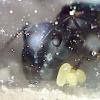I got a colony of Camponotus (Tanaemyrmex) (correct me if I'm wrong drew, they do resemble your pictures of C. vicinus) about a month ago. One worker eclosed and it looks like they have one larva left so I'm starting to think about hibernating them. It just feels wrong putting your beloved pets in the fridge, so I want to make sure this is done correctly.
My understanding is they are ok to hibernate with pupa or eggs, but not larva. Keep dark and maintain humidity. Anything else? How long do they need to be hibernated for?

















